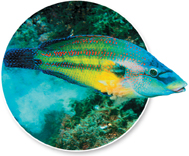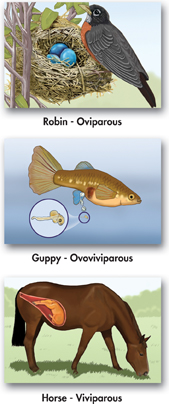
FIGURE 28–17 External Fertilization One type of external fertilization results from spawning. When aquatic animals spawn, females release eggs and males release sperm at the same time. Infer What is the cloudy substance behind this spawning male wrasse?
External Fertilization A wide range of aquatic invertebrate and vertebrate species reproduce by external fertilization.  In external fertilization, eggs are fertilized outside the body of the egg-producing individual.
In external fertilization, eggs are fertilized outside the body of the egg-producing individual.
▸ Invertebrates Invertebrates with external fertilization include corals, worms, and mollusks. These animals release large numbers of eggs and sperm into the water. Gamete release is usually synchronized with tides, phases of the moon, or seasons so that eggs and sperm are present at the same time. Fertilized eggs develop into free-swimming larvae that typically develop for a time before changing into adult form.
▸ Chordates Chordates with external fertilization include most nonvertebrate chordates and many fishes and amphibians. In some fish species, such as the wrasse in Figure 28–17, males and females spawn in a school, releasing large numbers of eggs and sperm into the water. Other fishes and many amphibians spawn in pairs. In these cases, the female usually releases eggs onto which the male deposits sperm.
Development and Growth
 Where do embryos develop?
Where do embryos develop?
After eggs are fertilized, the resulting zygote divides through mitosis and differentiates as described in Chapter 25. This development occurs under different circumstances in different species. The care and protection given to developing embryos also varies widely.
Where Embryos Develop Embryos develop either inside or outside the body of a parent in various ways.  Animals may be oviparous, ovoviviparous, or viviparous.
Animals may be oviparous, ovoviviparous, or viviparous.
▸ Oviparous Species Oviparous (oh VIP uh rus) species are those in which embryos develop in eggs outside the parents' bodies. Most invertebrates, many fishes and amphibians, most reptiles, all birds, and a few odd mammals are oviparous.
▸ Ovoviviparous Species In ovoviviparous (oh voh vy VIP uh rus) species, embryos develop within the mother's body, but they depend entirely on the yolk sac of their eggs. The young do not receive any additional nutrients from the mother. They either hatch within the mother's body or are released immediately before hatching. Young swim freely shortly after hatching. Guppies and other fishes in their family, along with some shark species, are ovoviviparous.
▸ Viviparous Species Viviparous (vy VIP uh rus) species are those in which embryos obtain nutrients from the mother's body during development. Viviparity occurs in most mammals and in some insects, sharks, bony fishes, amphibians, and reptiles. In viviparous insects, and in some sharks and amphibians, young are nourished by secretions produced in the mother's reproductive tract. In placental mammals, young are nourished by a placenta—a specialized organ that enables exchange of respiratory gases, nutrients, and wastes between the mother and her developing young.
Table of Contents
- Formulas and Equations
- Applying Formulas and Equations
- Mean, Median, and Mode
- Estimation
- Using Measurements in Calculations
- Effects of Measurement Errors
- Accuracy
- Precision
- Comparing Accuracy and Precision
- Significant Figures
- Calculating With Significant Figures
- Scientific Notation
- Calculating With Scientific Notation
- Dimensional Analysis
- Applying Dimensional Analysis





